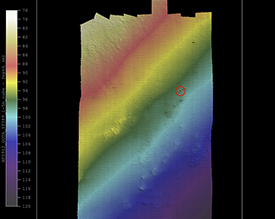ex-USS YP-389

Ship Stats
Vessel Type: New England fishing trawler converted to a U.S. Navy patrol vessel
Length: 102.5 feet Breadth: 22.1
Gross Tonnage: 170 Cargo: N/A
Built: 1941, Bethlehem Shipbuilding Co., Quincy, Mass.
Hull Number: 1512 Port of Registry: United States
Owner: U.S. Navy
Lloyd's Register Details: Four 6-cylinder diesel, oil engines
Former Names: Cohassett, AMc-201
Date Lost: June 19, 1942
Sunk By: U-701 Survivors: 18 of 24 (6 dead)
Data Collected on Site: Still and video photography; photomosaic; high resolution multibeam
Significance: During World War II, of the 36 U.S. Navy or U.S. Coast Guard district patrol craft (YP) sunk or damaged beyond repair, ex-USS YP-389 is the only one sunk by an enemy submarine and the only one sunk off the U.S. East Coast by enemy action. In addition, ex-USS YP-389 is a war grave to the six U.S. Navy sailors who lost their lives during the sinking.
Wreck Site

As a military vessel, the ex-USS YP-389 is protected by the Sunken Military Craft Act (SMCA), which was enacted on October 28, 2004. Pursuant to the SMCA, this vessel remains property of the U.S. regardless of its location or the passage of time and may not be disturbed without the permission from the U.S. Navy. To learn more about the SMCA, click here to visit the Naval History and Heritage Command web site.
The location of ex-USS YP-389 had been uncertain since its loss in 1942. In the early 1970s, great interest in locating the remains of the Civil War ironclad USS Monitor had developed and several expeditions were planned for that purpose. One such expedition, led by Dr. John G. Newton, took place in 1973 aboard Duke University research vessel Eastward. During the course of this survey, several targets were identified, and once they were determined to not be the Monitor, the team moved on. One of these targets was assessed as a 'twentieth century trawler' and subsequently dismissed after a cursory survey. It was later suggested by Dr. Robert Sheridan that this trawler might in fact be the remains of ex-USS YP-389.

Armed with this information, Monitor National Marine Sanctuary set out to relocate and possibly identify the site observed in 1973. The site was surveyed with multibeam sonar from the NOAA Ship Nancy Foster. Next, a series of remotely operated vehicle (ROV) dives were conducted to gather data, including still and video images and a photomosaic. After consulting with the U.S. Navy, the shipwreck was confirmed as the ex-USS YP-389. The site has been nominated to the National Register of Historic Places.

Historical Background
ex-USS YP-389 was first constructed as a steel hulled fishing trawler originally named Cohassett. Cohassett's fishing career was short lived because early in 1942, the U.S. Navy began to press into service every suitable seagoing craft. Therefore, on February 6, 1942, Cohassett was reclassified as a coastal minesweeper, AMc-201. After a short period as a minesweeper, the ship was once again refitted and reclassified, this time as a yard patrol vessel, ex-USS YP-389. In June 1942, ex-USS YP-389 headed south to North Carolina with the primary duty to patrol the Hatteras minefield and warn any merchant vessels that may stray off course.
The weaponry installed on ex-USS YP-389 was modest at best and quite ill-suited for fighting a surface battle with anything larger than a patrol boat. A chance encounter with a German U-boat would be a terrible mismatch! Nonetheless, that is exactly what happened. As ex-USS YP-389 patrolled off the Cape Hatteras minefield, it cruised the outskirts of the minefield's north to south buoy and then returned on the same track. The German U-boat, U-701, had arrived on June 16 and was ready to sink ships. However, U-701's captain, Horst Degen, became frustrated with ex-USS YP-389's repetitive patrolling as it was hindering his plans to watch for merchant shipping.
Hence, at 2:45 am, on June 19, much to the surprise of the ex-USS YP-389 crew, U-701 began to attack. Since the patrol vessel was small, U-701 did not want to waste a valuable torpedo, but it also did not want the vessel to report their position or attack with depth charges. As a result, U-701 attacked with its deck gun. This resulted in an exchange of surface gunfire between the two vessels, which lasted for over an hour and a half. Before ex-USS YP-389 sank, the crew abandoned ship in lifejackets as their lifeboats had been destroyed in the gun battle. They floated in the water until the next morning when they were rescued at about 8:00 a.m. by two Coast Guard cutters; six of the crew died during the battle. About two weeks later, U-701 was sunk by Army aircraft in the same vicinity.
Twenty-four men were onboard ex-USS YP-389 when it sank. A confidential crew list was compiled showing if they died, survived or were missing. The extent of their injuries, if any, were also noted. The list was eventually declassified. The injured were either taken to Morehead City, North Carolina, or Norfolk, Virginia, depending upon the severity of their injuries.


3-D Model
3-D Model of USS YP-389 lost off the North Carolina coast on June 19, 1942, during the Battle of the Atlantic, with the loss of six U.S. sailors. Credit: NOAA/Project Baseline
Video
Video clip depicting the story of the battle between ex-USS YP-389 and U-701.
To view other Outer Banks Maritime Heritage Trail videos, click here.
Site Plan

To view additional site plans click here.

